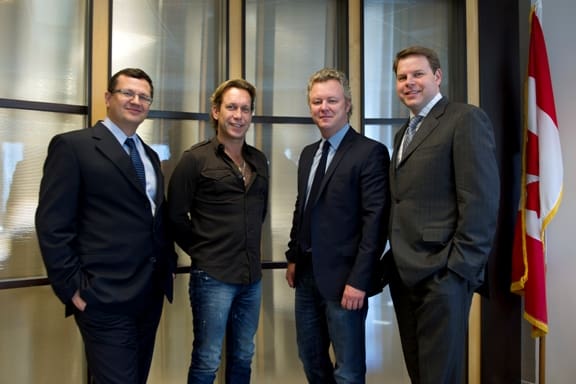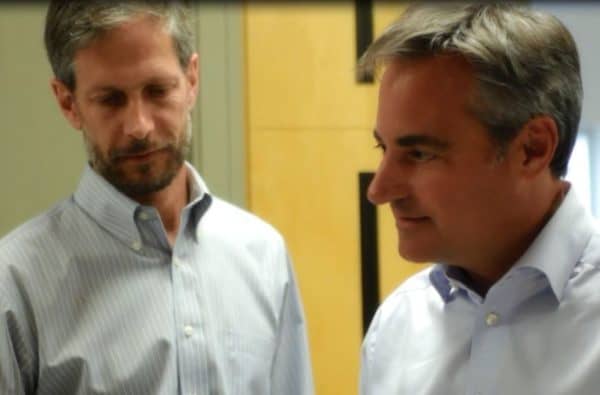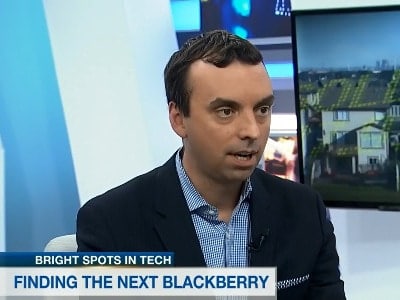

The TSX is undergoing a sea-change. Throwing a dart at a board lined with resource sector tickers hasn’t worked for a while, and likely won’t again for some time.
And despite a recent lift, the same can probably be said of the technology sector. Technology is exciting, promising, and almost certainly still undervalued in Canada. But it does not come risk free.
For investors who have grown comfortable with the lexicon of mining terms such as “core sample”, “proven probable”, or “cut-off grade”, the terms “pivot” “big data” and “social discovery” might present a barrier to entry. So how does the average Canadian investor get exposure to the tech sector without becoming the dupe who invests in an online pet food company with a puppet mascot?
Enter Difference Capital (Difference Capital Stock Quote, chart, News: TSXV:DCF), a publicly listed merchant bank that was created a year ago to invest in technology, media, and intellectual-property rich industrial companies. Difference has made a splash because of the amount of money it has raised and deployed, and because its Executive Chairman and co-founder, Mike Wekerle, is a certified Bay Street legend.
But there’s more to Difference Capital than Wekerele. A lot more. We kicked “Wek” out of the room to talk to to three of the well-known industry veterans who are staking the second parts of the respective careers on the idea that there is more to the public markets in Canada than mining and metals, and who have Difference Capital positioned to reap the benefits of a long overdue reversion to the mean.
Recently, Cantech’s Nick Waddell talked to co-founder Paul Sparkes, CEO Neil Johnson, and the company’s Head of Investment Strategy, Tom Astle.
Paul, how did Difference Capital come together?
Paul Sparkes: Just over a year ago and a half ago, Michael Wekerle and I started thinking about what we were going to do together. We knew that we wanted to be in the technology and media space, as Michael saw a change coming in the markets and I had a keen interest in media given my background. Shortly after Henry Kneis joined us, we discovered an opportunity through a public vehicle called TriNorth that had over $150 million in tax losses. We were easily convinced that this was the right vehicle for us to roll all of our strategies under. Then I was introduced to Neil Johnson through my relationship with his stepfather, John Reynolds, who is a former Conservative MP. We then began to build our team adding Jeff Kehoe, Tom Astle and Jamie Brown.
How did you know John Reynolds?
Paul Sparkes: John and I actually worked together in my CTV days. We were on a trip together and I was explaining to John what we were up to, and he said, “You know, you should meet my son Neil, who is at Canaccord who just returned from London and is now in Toronto… he would be a great fit for you guys.” So I arrived back into Canada and immediately called Neil, and we hit it off. He had the same vision as us. His background certainly was in technology and media. As the lead banker for that space in London, he had seen a lot of those companies, and had been part of the explosion of those industries over in London. And he too, saw the opportunity in technology and media that was coming here, given what was happening on the resource side. So between myself, Michael, Henry and Neil, we claimed sort of a little corner of Bay Street. As Neil was moving his boxes out of Canaccord, I said, “Where are you moving your boxes?” He said, “I’m bringing them home.” I said, “Why would you do that? Why don’t you just move them into our office?” That was a way of making a deal with Neil. We were happy to have Neil join us.
Neil Johnson: It was a real seamless transition (laughter). We set out to raise our first bit of capital, which was $30 million at the outset, and then closed the additional $55 million just before November. Since then, we have done about 20 different investments. We’ve expanded our team. We’re very glad to have Tom Astle join us, given his background and pedigree. Jeff Kehoe brings a great skill set to our team, and balances out on the governance side, especially in compliance and being our general counsel. Jamie Brown, who is a former colleague of mine, was a great catch for us to round off a really great team.
Neil, collectively your team has a ton of experience in the public markets. I’m thinking of Wek, of Jamie, of Tom and Jeff Kehoe. There’s talk in Canada of a sector rotation. Tech was the top performing sector last year, and now we’re up 20% now, I think, this year so far. Can you characterize this time and place in the market? To the average investor, who maybe they bought mining stocks for 10 years and they’ve done pretty well, and now all of a sudden, they’re not. What’s going on?
Neil Johnson: Let’s look at one of the guys who is considered a thought leader in the mining and metals space, Frank Giustra. Frank got out of the mining game in 1996 and started Lions Gate Entertainment. In 2000, he handed the reins of Lions Gate over to Jon Feltheimer, and saw an opportunity that was the resource bull market. He collected a group of high-quality individuals that had traditionally been in mining. He saw that the sector rotation was coming back for resources. That was in 2000. The resource boom, probably if you point back to, you know, when things really got cranking was maybe late 2001 or 2002. So it takes two years. We started this a year ago. I would categorize this as a 2001-type resources, that you knew that the internet bubble was over. It was a capitulation that things don’t trade at 150 times next year’s revenues for long. So that was in 1999, and it was March 2000 that was the peak. I would say we’re in 2001. If you look at gold, if you look at copper, these things have come off the tops. The junior mining cycle, there’s some capitulation. Now, I do not want to say that the resource market is over. There’s global structural trends that you can point to, that people will need metals and mining and oil and gas and resources for a long time. But we don’t need the resource market to be over in order to enjoy a sector rotation back to the mean of a normalized capital market, which includes tech, media and growth company sector.

So we were just talking about a reversion to the mean. You’re not talking about anything that’s unprecedented going on here…
Neil Johnson: If we revert to the mean, it’s still $200 billion of capital that should keep going back to this sector.
In Canada…
Neil Johnson: In Canada alone.
That’s incredible. It’s surprising how far tech fell out of favour in Canada. I mean, like I said, it fell at one point to 1.6% of the value of the TSX. If that was a 12-year bull market in resources, that was the longest bull market that I’ve ever seen, and I’m 43. I think it had the effect of making people forget that markets are cyclical.
Tom Astle: The debate is what’s going to happen to the supercycle. As Neil said, we’re not assuming that’s completely over, but we just need things to moderate a little bit, which it has, and so we have begun this reversion to the mean.
Neil Johnson: The technology industry, if you want to compare the two, that didn’t go away either. There were many very good companies that blossomed from 2000-2012. But what happened was, the weaklings that everyone poured into from 1996-2000 disappeared. Anything with two guys and a business plan got financed in that period in technology. Then everyone realized, the greater fool theory only lasts for so long. I would say that there will be some consolidation in the junior end of the mining, just like there was in the start-up end of technology. And you know what? That’s healthy for capital markets. It’s healthy for an economy. It’s healthy for everyone. It’s the Darwinian theory, right? Unfortunately, human nature, this goes back way before the year 2000. Human nature is whatever is successful gets overdone. What Frank Giustra did was that he went and picked the cycle at the correct time. We have been at it now a year and we believed we picked the cycle a year ago correctly, and what we’ll see within the next year are the fruits of all our labour.
To that end, my impression of Difference Capital, is that in part it’s simply a necessary transition product for investors right now. Tom, you and I were talking about this last week; if we go from 1.6% of the market to 8%, or 9%, or 10%, those are some major moves. And I think for the average investor out there, maybe a guy who’s been buying mining stocks, Difference Capital gives them an opportunity to participate in the world of tech without having to go back and completely relearn everything they knew about investing. You get exposure to tech without making a bet on one company maybe that goes bankrupt or, you know, one particular asset. It gives the average investor exposure to something where they can maybe learn something about the sector as well.
Paul Sparkes: Well, it’s diversification. It’s access to a private company universe that they would never have exposure to…
Neil Johnson: That’s right. We’re investing in private companies that in two or three years, hopefully, will be the new IPOs. Take Halogen Software. If you look at their principal investor, a venture capital firm called JMI, they’re up four to five times their investment I believe. Difference Capital is diversified. We invest in private companies that you wouldn’t have exposure to. We’re a public company, you’re not 7-10 years locked in to a venture capital fund or a private equity fund. Most importantly, you’re standing on the shoulders of an experienced team that has more than a century of experience in financing and advising growth companies.

Paul Sparkes: You’re absolutely right. Just to build on that, our investor base is family and friends with some additional investors. One investor in particular was looking into making an investment alongside his partner in a company. The two did not really understand the business that the company was involved in. At the end of the day, the investor said to me, “I’m going to give my money to you guys,” because Difference Capital is diversified in the technology space.
Neil Johnson: The one difference that we have is that we are not just a basket of assets. We are not just an investor that gets you exposure to these companies that we invest in. We are a specialty financial company that advises these companies and generates fees for helping the companies navigate their growth initiatives. We can help them in multiple ways. Now obviously, we have to bend to the capital markets, but strategic advice, acquisition advice, and international exposure, Jamie Brown being seven years as president of the US, and I headed Canaccord’s UK operation, the largest Canadian investment bank in equities over in Europe, and I was there for 10 years. So our networks can help companies in a lot of different ways, as well as government relations and access to government funding, which is an important part of a cleantech or healthcare company’s survival. Those fees that are generated come back and we share them with Difference Capital Funding, the public company. So there’s a revenue stream for our public shareholders that will support the specialty financial aspect of our business.
Share price appreciation is one way you profit. But there are different ways you can make money…
Neil Johnson: Well, what we are doing is, we are giving the public shareholders access into everything that we do, which is more than just invest. We are also advising these companies. Therefore the revenue that comes from our fee generation is shared with the public company. So the public company is not just a basket of assets. It’s not just a holding company of small interests in companies. It is a financial services company that has a profitable revenue stream.
Okay, we’ve covered some of your public investments: Guestlogix, Amaya Gaming, CRAiLAR, extensively. What are some of the privco investments that you’re really stoked about right now?
Neil Johnson: Well, our wheelhouse, in terms of what the size and what we’re looking for, you know, we’re looking to put $3-$5 million into our core investments. We are an investor that wants to take a significant or influential role. So an influential stake, which is probably 10-20% of a company that we are invested in. We then have active role. I think we give a lot of value-add to companies. We are not imposing any of our networks and advice onto companies. But if they want to use our networks and advice, that is what we can provide for them. And that is kind of the size of investment that we are looking for. Tom could talk more about investable themes….
Tom Astle: Yes, on top of that, I would also say we are not doing start-ups, we are not doing seed rounds. We are looking for companies that are post-revenue. Companies that have customers we can call, companies that are IP-rich. That’s the criteria we articulate to everybody. Right now we are pretty excited about a couple areas. We have this very strategic investment in Virgin Gaming, for example. The whole gaming space is an area we have a lot of expertise in. It tends to generate great business models. And we are particularly excited about that one. We are very active in the media space, in the whole second screen market, for example. We have a couple investments in that area. And then another area we are very busy right now in is what we will call social commerce, at least two investments in companies, if not three, that use social networking, social media to enhance marketing and advertising significantly. A lot of activity is happening there right now. Our focus there is a company called Appinions. It’s a Dennis Bennie company, based in Manhattan, doing some really interesting stuff around social media and advertising. But we’ve got three or four major areas we’re focusing on, but those are the overlying criteria.

Do you have the ability to invest more if you see an opportunity, or are you going to stick to the $3-$5 million per?
Tom Astle: No, we would definitely grow with the companies. There are a number of our companies we have invested less than that. We call them kind of strategic investments. And the strategic investments, for one reason or another, we haven’t been able to put our full size into these companies. And so, as they grow and as they complete milestones, we have dry powder to invest in subsequent rounds. And I think that’s a healthy model that we will employ to help companies.
Neil Johnson: In Virgin, we flowed a total of approximately $19 million into the company. Sold a little bit recently at a 20% profit. So we do have the ability to go higher, and larger transactions that are quite large, we will seek partners, private equity partners, to go with us on certain investments.
You’ve raised, I think, $80 million so far?
Paul Sparkes: $85 million.
Are you always going to be fully invested, or are you going to keep some in cash or can you talk liquidity a little bit?
Neil Johnson: Well, in terms of fully invested, it’s permanent capital. So our main driver is to continue to generate returns for our investors. Those come in both appreciation in the value of our stakes, but also in the recurring revenue stream of our advisory services. So the fact of the matter is that our preferred method of investing is convertible debentures. That’s the top of the capital table. We have a revenue stream and an income stream coming off of the investments. If things are not happening to our liking in two or three years, we get our money back. But our main goal is to help the entrepreneurs achieve their goals so that we play in the upside and get equity returns from our structure.
As far as geography goes, do you guys feel that you have an advantage looking at Canadian companies? I know that you have a mandate that allows you to invest internationally, but do you think that you have an advantage looking at stuff in your own backyard?
Paul Sparkes: Well, I think we do. I think we have an advantage. We are new players in this space…but a very experienced team. For a team coming together in a relative short period of time, we have generated a lot of attention. Our willingness to invest, put our reputations and our capital to work and leverage our collective networks to invest in companies right here in Canada is a great place to be. Canada’s also a real hotbed of activity, especially in the tech space right now and we have first mover status with Difference.
I think part of the reason for the boom in a number of companies is that they’re cheaper to start now than they were back in the dot.com days.
Neil Johnson: I agree.
They’re also customer-facing a lot more quickly. So you can sort through the winners and losers. I remember IPOs back in 1998-’99, where you would have a company going public and no one really knew whether it worked at all. Now they’re up on social media, you’re looking at how sticky things are, how much people like them, by the time they put five or ten grand into the company, in some cases.
Paul Sparkes: Most of our companies have the ability to monitor their activity on a daily basis and make adjustments on the go. It’s pretty amazing what technology brings.
It must be pretty exciting for you guys at this stage in your careers. I mean, I know that you’ve brought a level of excitement to the tech sector that hasn’t been in a long time, but for you guys personally, it must be a real jolt of energy…
Paul Sparkes: Being a corporate guy, and spending the majority of my career in corporate boardrooms, in Ottawa, Toronto and in the government, I think I can speak for everyone else, we have all had great careers, we have all done great things, and most of us are in our mid-late 40s. We have come together because we want to make the next 20 years of our lives the most exciting 20 years that we have left, and maybe more. But there is a real opportunity for us personally to take this leap. I think that we are in the right space at the right time. We have the best team on the street to execute.
Neil Johnson: Well, the other thing I would add is that you look around at the venture capital, and you talk about ’98-’99, all the money flowed into this venture capital labour-sponsored fund, that structure, which had to invest at the top of the market and then had to divest at the bottom of the market. That is where no new money has flowed into this sector, in the private way. We have just reinvented the structure. That is the area that we want to focus on. It has been wiped out, not completely, but there’s a lot less competition for us to invest than there was 10-15 years ago. Our structure is a public company, and you talked about that, which gives everyone the benefit of liquidity, transparency, and also yield that’s coming, in our company. That’s kind of a modern version of how we’re going to finance the venture capital in this country. That is the biggest opportunity that I have been involved in in my career. Let me tell you, I was in the beginning of the AIM wave of that took over the capital markets in Europe and was like drinking from a fire hose. It was very exciting and I feel the same excitement that I did back in the early days of Canaccord’s UK office that I do here. The opportunity is massive, and we have a much better team of senior guys now than we ever did in the early days of Canaccord when we took over that UK firm. So yeah, it’s very exciting. The fact that now we are an investor and an advisor, we realize that companies, when you are sitting in the boardroom as a partner, as a real partner, as a true investor, and you are now talking about how to attack and how to grow and how to raise capital, it’s a much different conversation than being an investment banker, that there’s a natural skepticism. I didn’t realize how much skepticism there was from CEOs until I was not an investment banker.
Tom Astle: It is also a different conversation than venture capitalists would have. Because we bring a lot of different value, we think, in terms of advice and stuff.
Neil Johnson: We don’t take majority stakes. We are influential, but we are also management friendly, I’d say. And right now, we can be. We don’t have a built in time horizon to get out of investments. So there’s not a rush to invest, and not a rush to divest. But let me tell you, if you were buying a lot of resource assets in 2000 and 2001, when 2003-’05 and 2007 comes along, by default you are making a lot money because you have invested in the right time in a cycle.
One of my favourite quotes is from Bob Hope and was about how he became the largest private landholder in the United States. He said, paraphrasing here, “Real estate investing is easy. You just buy at the edge of town and you wait.” I have always felt that the pendulum’s got to swing back in Canadian tech. And now in the past month, it finally feels like it is, but one of my worries right now is that, what if this just lasts for six months or a year? What do you think about that? Do you think this is going to be a longer term 3-5 or six year trend?
Paul Sparkes: You know, coming from my background, I actually believe this is a longer trend. It goes back. I think you can look at the basis of where consumers are today, and what they’re buying, how they’re getting information, machinery is different today than it was 10 years ago. Machines now talk to each other, where before you needed people to run them. And Tom could speak more about it, but I truly believe this is a long run. You know, resources are still going to be a big part of our lives. We still have to build houses and buildings, and there has to be commodities that make our lives run. But at the same time, technology is now a big part of our lives, and it’s changed so much. I know from the media world, when I started in the media business in 2000, Jean Monty had this great vision of convergence and bringing all traditional broadcast media and digital properties together into one house. It was a great idea, but it was before its time. And now, 10 years later, its happened. The ideas of 10 years ago are now real and are all part of our lives and in 10 more years it will be different again.. It is completely converged. It is our time, and it’s going to grow significantly.
Neil Johnson: I think, Nick, with Cantech you’ve bought on the edge of one town, okay? But what we’re investing in is different towns. The analogy is, you’re worried about the public markets, if this is three to five years of a bull market in technology in the public Canadian market. That would be one exit for us, and our portfolios of companies have a number of potential exits. One of our skill sets is that we’re always thinking of multiple exits. Whether it’s an M&A transaction by a big US private equity firm that Jamie Brown will have known and dealt with for the last seven years, or whether it’s an acquisition from a European company that I can transact and I can steer in the right direction, or if the Canadian capital market is open for business and that’s the right way to go, you know, there are multiple exits for our companies, and that’s why they’re gravitating to us. We are not a one-trick pony. We have a team that has multiple ways to create value for our investing companies.
That’s a great point, Neil. I think that what we’re looking for, from a Canadian public markets perspective, is to simply become a viable alternative again…
Neil Johnson: And having said that, Halogen Software, the book was four times oversubscribed, the institutional book. But here’s the most impressive stat. One of the co-managers, so not the lead, one of the co-managers on that deal that I won’t name, had a retail demand of over a million shares, their allocation was 40,000 shares.
Wow.
Neil Johnson: So that’s the retail side. You know, not only was it great to see that the institution demand was four times over. That hasn’t happened in a long time. But the retail demand is back, and therefore I think that this is a sustainable up-leg. As we say, you look at the capital markets that we track, and we’re severely underinvested, and look at retail investor’s portfolio in Canada. It’s a good thing to have a resource company that doubles, triples, goes up 10 times, but it overcrowds your portfolio if you don’t sell and you reinvest in the next gold mining or the next oil and gas that you’ve had success with. But when that music stops, you look for good value and that’s where we’re finding investors now pointed. They’ll see a lot of value in our investible areas for a long time.
Comment
One thought on “More than “Wek”: Cantech Letter interviews Difference Capital”
Leave a Reply
You must be logged in to post a comment.





 Share
Share Tweet
Tweet Share
Share




I wish them success. It’s nice to see Canadian investors taking a stab at the tech sector. What’s missing in this piece and in the commentary is competition. I think DC is going to have a very difficult time deploying $3-$5MM per (high quality) company (while expecting a 10 to 20%) stake without bumping into top tier VCs from the US. In fact, it’s really hard to deploy less than $10MM to companies at a time without coming across the NEA’s, Kleiners and Benchmarks of the world…and those guys are focused almost exclusively on tech….this is why the C100 was formed – to expose Canuck entrepreneurs to heavy hitting financers who know tech. At any rate, it will be nice to see how things go.